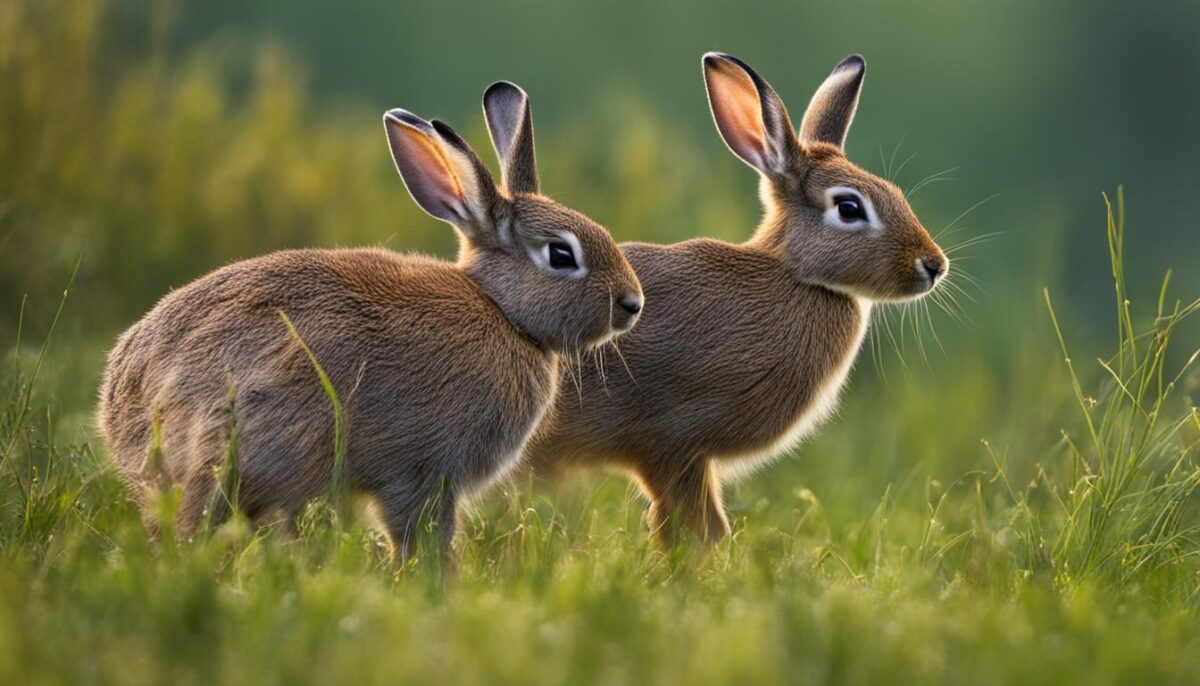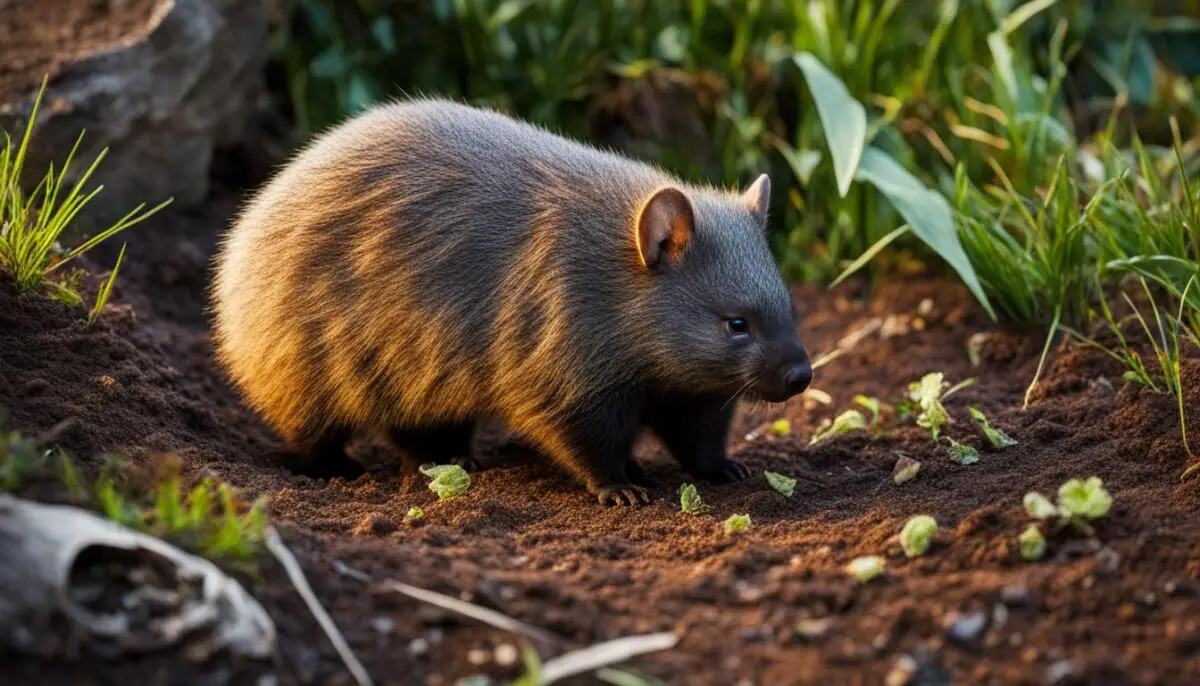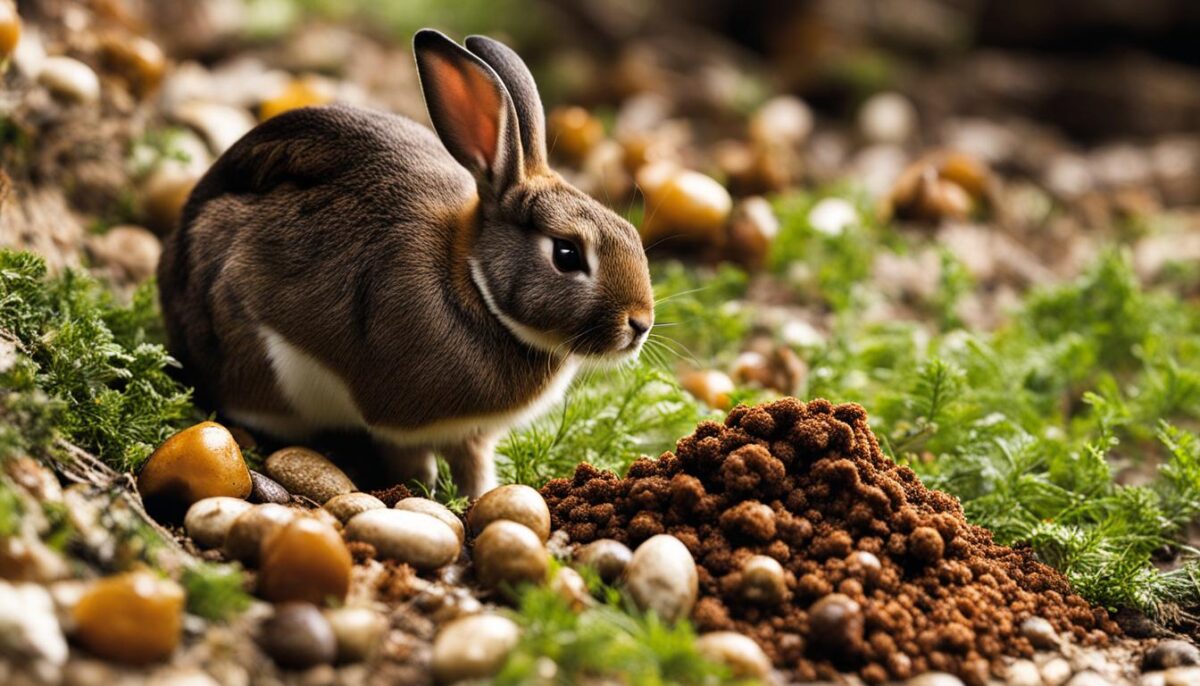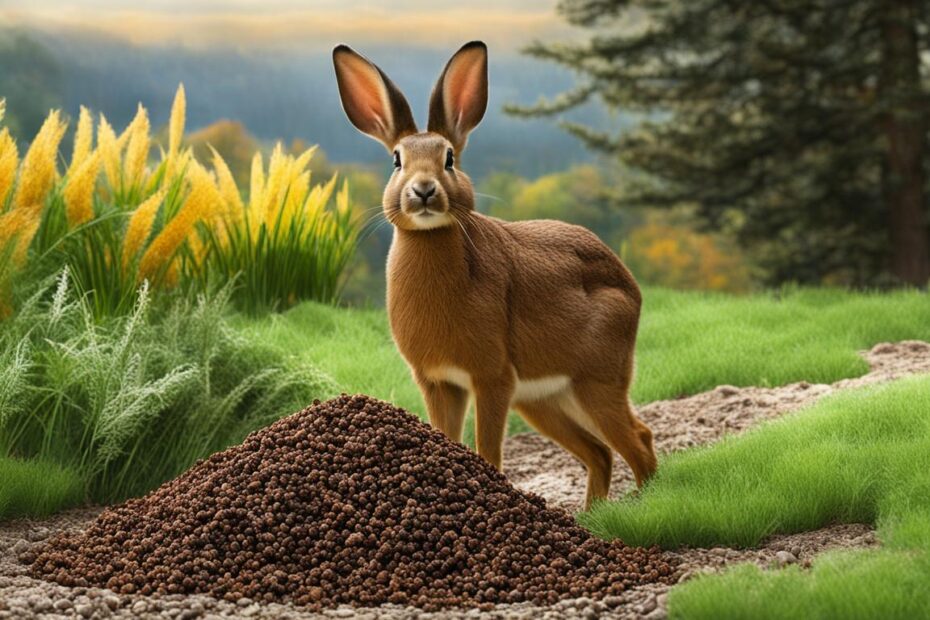Welcome to our informative visual guide on the comparison of rabbit poop and deer poop. In this article, we will explore the visual differences between rabbit droppings and deer droppings, providing you with a comprehensive understanding of these two types of feces. By examining pictures of rabbit and deer poop, we will highlight the key characteristics that distinguish them from each other. Whether you’re a nature enthusiast, wildlife researcher, or hunter, this guide will help you accurately identify and differentiate between rabbit and deer feces.
Key Takeaways:
- Rabbit poop and deer poop have distinct visual differences that can be observed and compared through pictures.
- Identifying scat involves observing location, size, shape, and contents.
- Rabbit poop is tubular and pellet-like, while deer poop is larger and clumps together.
- Studying scat provides valuable insights into animal populations, diets, and behavior.
- Understanding the differences between rabbit and deer poop is essential for wildlife management and conservation efforts.
Importance of Studying Scat
Studying scat is an essential and non-invasive method for understanding animal populations and communities. By analyzing the feces of various species, researchers can gain valuable insights into their diets, movement patterns, habitat usage, and spatial overlap with other animals. This information is crucial for wildlife management, conservation efforts, and understanding the impact of human development on animal behavior and resource competition.
One of the key advantages of studying scat is that it allows scientists to gather data without directly interfering with the animals or their habitats. This non-invasive approach is particularly important for studying elusive species or those that are sensitive to human disturbance. By collecting and analyzing scat samples, researchers can gain valuable information about animal diets and the presence of different species in a particular area.
“Scat analysis is a powerful tool for understanding animal populations and their response to environmental changes. It enables us to evaluate the effectiveness of conservation measures and make informed decisions about land management.” – Dr. Jane Wilson, Wildlife Biologist
Scat analysis also provides valuable insights through DNA extraction. By analyzing the genetic material present in scat samples, researchers can identify the species responsible for the feces and gather precise data on their diets. This technique is particularly useful for studying carnivores and understanding their dietary preferences and interactions with prey species.
Table: Examples of Scat Analysis Findings
| Species | Diet | Scat Characteristics |
|---|---|---|
| Red Fox | Small mammals, birds, fruits | Tubular scat with tapered ends, often containing bones or hair |
| Black Bear | Fruits, nuts, insects, occasionally small mammals | Very large scat that may contain seeds |
| Gray Wolf | Large ungulates, small mammals | Tubular scat with tapered ends, often found in multiple deposits along trails |
| Bobcat | Small mammals, birds | Segmented scat, may be accompanied by a scrape on the ground |
Overall, studying scat provides valuable insights into animal populations, their ecological roles, and the dynamics of their interactions within ecosystems. It is a powerful tool for researchers, wildlife biologists, and conservationists aiming to protect and manage animal species and their habitats.
Identifying Scat
To accurately identify scat, several factors should be considered such as location, size, shape, and contents. These elements provide essential clues to determine the animal species responsible for the scat. By carefully observing these characteristics, nature enthusiasts, researchers, and wildlife experts can gain valuable insights into the animal’s diet and behavior.
The location where the scat is found can be an important clue. Different animal species have specific habitats and territories, so identifying scat within their known range can help narrow down the possibilities. Once the location is established, attention should be paid to the size and shape of the scat. Size can vary significantly between different animals, ranging from small pellets to larger clumps.
The shape of the scat can also provide valuable information. Some scat may be tubular, while others may be tapered, twisted, or pellet-like. Additionally, examining the contents of the scat can offer further insight into the animal’s diet. The presence of specific materials such as berries, hair, seeds, or sawdust can help identify the animal species responsible for the scat.
By combining careful observation of location, size, shape, and contents, it becomes possible to accurately identify scat and gain a deeper understanding of the animal populations and communities present in a given area.
Table: Characteristics for Identifying Scat
| Characteristics | Significance |
|---|---|
| Location | Provides insight into the animal’s habitat and range |
| Size | Varies between different animal species |
| Shape | Tubular, tapered, twisted, or pellet-like |
| Contents | Berries, hair, seeds, sawdust, etc. indicate diet |
Scat Morphology and Diet
Scat morphology can provide valuable insights into an animal’s diet and feeding habits. Different types of scat can indicate the specific foods an animal consumes, allowing researchers to better understand their ecological role and interactions within their environment. Here are some common scat morphologies and the corresponding animal diets:
Table: Scat Morphology and Animal Diet
| Scat Morphology | Animal Diet |
|---|---|
| Scat with hair and bone | Meat and organ diet |
| Twisted, tapered ropes | Fruit consumption |
| Shapeless or loose tubes of crumbly material | Grass or herbaceous plants |
| Blunt or tapered ends | Ungulates, rabbits, squirrels, chipmunks, porcupines, etc. |
| Tubular scat | Canines, felines, raccoons, etc. |
By examining the morphology of scat, scientists can gain valuable insights into an animal’s diet and feeding behaviors. This information can be used to study food webs, track changes in animal populations, and assess the health of ecosystems. Additionally, scat analysis can aid in the identification of animal species, particularly when physical observations or tracks are not available.
Scat morphology is like a window into an animal’s dietary preferences. By analyzing the shape, texture, and contents of scat, we can unravel the mysteries of an animal’s diet and its ecological role. It’s fascinating to see how different animals have adapted to consume different types of food, and scat provides us with a tangible record of their dietary choices.
Understanding scat morphology and its relationship to animal diet is vital for various fields, including wildlife management, conservation, and ecological research. By studying scat, scientists can gain a deeper understanding of the intricate connections that exist within ecosystems and make informed decisions to protect and preserve biodiversity.

Deer Scat vs Rabbit Scat
When it comes to differentiating between deer scat and rabbit scat, size and appearance play a significant role. Deer scat is similar in size to chocolate-covered raisins, while rabbit scat is smaller, resembling the size of M&M’s. This size difference can be a useful indicator in distinguishing between the two.
Another noticeable distinction is the way these scats clump together. Due to their high moisture content, deer scat tends to form clumps, whereas rabbit scat may appear darker and wetter initially, but will eventually dry up and contain fibrous material. These unique characteristics offer additional insight when trying to identify the scat of deer and rabbits.
To provide a clearer visual representation, let’s take a closer look at a comparison table showcasing the differences between deer scat and rabbit scat:
| Characteristics | Deer Scat | Rabbit Scat |
|---|---|---|
| Size | Similar to chocolate-covered raisins | Similar to M&M’s |
| Clumping | Yes | No (dries up and contains fibrous material) |
Remember to exercise caution and avoid direct contact with scat, as it may contain parasites and pathogens that can be harmful. If you come across any scat during your outdoor ventures, use these distinguishing characteristics to help determine whether it belongs to a deer or a rabbit.
Other Animal Scat Types
While rabbit and deer scat are commonly encountered in nature, there are many other animals with distinctive scat types that can be identified through careful observation. Understanding these differences is essential for accurate animal identification and tracking. Here are some examples of unique scat characteristics from various species:
Cottontail Scat
Cottontail scat, similar in size to M&M’s, is commonly found in grassy areas and gardens. It can be identified by its small, round pellets. The scat may appear darker and wetter initially, but re-digested scat will be dry and contain fibrous material.
Beaver Scat
Beaver scat looks like clumps of compressed sawdust and is often found near water bodies. The scat is an important sign of beaver activity and can help identify their presence in an area.
Skunk Scat
Skunk scat is small, tubular, and can contain insect parts or seeds. It is commonly found near skunk dens or along trails. Identifying skunk scat can be useful for understanding their movements and habitat usage.
| Species | Scat Appearance |
|---|---|
| Cottontail | Small, round pellets |
| Beaver | Clumps of compressed sawdust |
| Skunk | Small, tubular, may contain insect parts or seeds |
By familiarizing yourself with the scat characteristics of various animals, you can gain valuable insights into their presence, behavior, and habitat preferences. Always remember to observe scat from a distance and avoid touching it with bare hands to prevent the risk of exposure to parasites or pathogens.
Scat of Carnivores and Omnivores
In addition to herbivores, scat analysis is also crucial for understanding the diets and behaviors of carnivorous and omnivorous animals. By studying the appearance and contents of scat, researchers can gain valuable insights into the diet and habitat preferences of these animals.
Carnivores like red foxes, coyotes, and wolves produce tubular scat that is often tapered at one end. This scat may contain bones or hair, providing evidence of their meat-based diets. The scat of these carnivores is commonly found on trails and trail crossings, with multiple deposits often present in the same area.

Another interesting scat characteristic can be found in microbats. These small bats, often found in roofs and chimneys, produce scat similar to mouse poo. However, it has a drier consistency and can be easily distinguished from other types of scat.
Scat provides valuable insights into animal diets, behaviors, and populations. By studying scat, scientists can gather important data on animal populations, diets, and interactions within ecosystems.
Emus, the flightless birds native to Australia, also have unique scat characteristics. Depending on their diet, emu scat can vary in appearance. Some may resemble wet cowpats, while others take on a brownish pyramid shape with a high seed content.
Table: Unique Scat Characteristics
| Animal | Scat Appearance | Characteristics |
|---|---|---|
| Wombat | Square-shaped | Due to slow digestive process |
| Microbat | Similar to mouse poo | Drier consistency |
| Emu | Varies | Depending on diet, can resemble wet cowpats or brownish pyramids with high seed content |
Lastly, dingo scat, found in areas where dingoes roam, is similar in appearance to medium-sized dog droppings. It can provide insights into the presence and habits of dingoes in a given area. Fox scat, on the other hand, looks more like cat poo, with a dark brown to black color and a dry, stringy appearance.
These unique scat characteristics allow researchers and nature enthusiasts to identify and study different animals based on their droppings. Understanding scat can provide valuable insights into the presence, behavior, and diets of various species.
Scat Identification Tips
When it comes to identifying scat, there are several key tips to keep in mind. By following these tips, you can enhance your ability to accurately determine the animal responsible for the scat you’ve encountered. Let’s take a look at some helpful strategies for scat identification.
1. Consider Animal Tracks
One effective method for scat identification is to consider the nearby animal tracks. By examining the tracks in combination with the characteristics of the scat, you can gain a clearer understanding of the species responsible. For example, if you find scat near tracks that belong to a deer, it’s likely that the scat is from a deer as well.
2. Use a Measuring Tool
Size is an important factor in scat identification. Using a measuring tool, such as a ruler or tape measure, can help you determine the size of the scat more accurately. This information can further aid in distinguishing between similar-looking scat from different animals.
3. Observe Shape, Location, and Contents
Examining the shape, location, and contents of the scat can provide valuable clues for identification. Different animal species produce scat with distinct characteristics. Pay attention to the shape, noting whether it is tubular, tapered, or pellet-like. Consider the location where you found the scat, as certain animals have preferred habitats. Additionally, take note of any recognizable contents within the scat, such as hair, seeds, or berries, which can provide further insight into the animal’s diet.
By incorporating these scat identification tips into your observations, you can become more adept at determining the animal responsible for the scat you encounter. Remember to exercise caution and avoid touching scat with bare hands, as it may contain parasites or pathogens. Happy scat identification!

| Scat Identification Tips | |
|---|---|
| Consider Animal Tracks | Examine nearby tracks to help identify the species responsible for the scat. |
| Use a Measuring Tool | Measure the size of the scat using a ruler or tape measure for more accurate identification. |
| Observe Shape, Location, and Contents | Note the shape, location, and contents of the scat to gather clues for identification. |
The Importance of Scat Analysis
Scat analysis plays a crucial role in animal research and conservation efforts. By studying animal droppings, scientists can gather valuable insights into the populations, diets, movements, and habitat requirements of various species. One of the key techniques used in scat analysis is DNA extraction, which enables researchers to identify the species present in the environment, even when physical evidence is lacking.
This non-invasive method of collecting and analyzing scat provides valuable data for wildlife management and understanding ecosystem dynamics. It allows researchers to track changes in animal populations over time and assess their response to environmental factors. Scat analysis is particularly useful in studying carnivores and omnivores, as it helps determine their dietary preferences and spatial overlap with other species.
To illustrate the importance of scat analysis, consider the example of a study on a local fox population. By analyzing the DNA extracted from fox scat samples, researchers can determine the genetic diversity of the population, identify individuals, and track their movements. This information can then be used to assess the health of the population, understand their foraging patterns, and design effective conservation strategies.
Benefits of Scat Analysis
Scat analysis offers several advantages over traditional methods of studying wildlife. Firstly, it is a non-invasive technique that does not require capturing or handling animals, minimizing stress and potential harm. Secondly, scat analysis provides valuable information on the diets of animals, shedding light on their ecological role and interactions within the ecosystem. Lastly, scat analysis is cost-effective and scalable, allowing researchers to collect data on a large scale and across different habitats.
| Benefits of Scat Analysis | DNA Extraction | Non-invasive | Insights into Diets |
|---|---|---|---|
| Provides valuable data for wildlife management | Enables species identification | Avoids capturing or handling animals | Reveals ecological role and interactions |
| Tracks changes in animal populations | Identifies individuals and tracks movements | Reduces stress and potential harm to animals | Helps design effective conservation strategies |
| Aids in understanding ecosystem dynamics | Assesses genetic diversity of populations | Cost-effective and scalable technique | Allows data collection on a large scale |
In conclusion, scat analysis is a valuable tool in animal research and conservation. Through the extraction and analysis of DNA from animal droppings, researchers can gather important data on species identification, diets, populations, and movements. This non-invasive method provides insights into ecosystem dynamics and helps inform wildlife management strategies. By understanding the importance of scat analysis, we can better appreciate the role it plays in preserving and protecting our natural world.

Conclusion
Understanding the differences between rabbit poop and deer poop is essential for various individuals, including nature enthusiasts, wildlife researchers, and hunters. By carefully observing the location, size, shape, and contents of scat, it is possible to distinguish between these two types accurately. To aid in this identification process, visual guides featuring images of rabbit and deer feces can be invaluable.
Studying scat, through visual comparisons and other methods, provides valuable insights into animal populations, diets, and interactions within ecosystems. This non-invasive approach allows scientists to gather important data without disturbing the animals or their habitats. Additionally, advancements in DNA extraction techniques enable species identification from scat samples, contributing to conservation efforts and wildlife management.
Identifying scat through images can be an effective method to differentiate between rabbit and deer feces. This visual guide provides a clear reference for distinguishing the distinct characteristics of each type of scat. By utilizing such resources and understanding the importance of scat analysis, researchers can track changes in animal populations and gain a deeper understanding of their response to environmental factors.
FAQ
What is the difference between rabbit poop and deer poop?
Rabbit poop is tubular and pellet-like, while deer poop is larger and clumps together.
How can I identify scat?
To identify scat, observe its location and placement, consider the size, shape, and contents of the scat.
What can scat tell us about an animal?
Scat can provide insights into an animal’s diet, movement patterns, habitat usage, and spatial overlap with other animals.
Why is studying scat important?
Studying scat is a non-invasive way to gather data on animal populations, diets, and interactions within ecosystems.
What are the visual differences between deer scat and rabbit scat?
Deer scat is similar in size to chocolate-covered raisins and can clump together, while rabbit scat is similar in size to M&M’s and can appear darker and wetter initially.
Are there other distinctive scat types?
Yes, there are various distinctive scat types for different animals, such as elk, moose, beaver, chipmunk, squirrel, porcupine, black bear, bobcat, raccoon, skunk, wombat, microbat, emu, dingo, and fox.
How can I differentiate between rabbit and deer poop?
Rabbit poop is similar in size to M&M’s, while deer poop is similar in size to chocolate-covered raisins and can clump together due to high moisture content in their diet.
What are some scat identification tips?
When identifying scat, consider the geographical location, use a measuring tool for size comparison, and search for nearby tracks to confirm the species.
How does scat analysis help in animal research?
Scat analysis allows researchers to gather data on animal populations, diets, movements, and habitat requirements. DNA extraction from scats enables species identification.
How can I distinguish rabbit droppings from deer droppings?
By comparing the size, appearance, and clumping behavior of the scat, you can differentiate between rabbit droppings and deer droppings.


